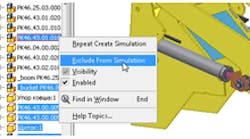Digital-prototyping software a highlight at Autodesk confab
Of the major CAD developers, Autodesk is probably best known for supporting the so-called “digital prototype” approach to product development. So it was no surprise that a main theme of the recent Autodesk Manufacturing Tech Day event in Lake Oswego, Oregon was that of interoperability. According to the developer, the 2010 versions of software such as Inventor, AutoCAD, Alias, and Navisworks allow almost seamless data transfer between the programs as well as with other CAD tools. This is important because the complete digital prototype — a true digital representation of the end product — provides a mechanism for teams to design, visualize, and simulate how a product will work under real-world conditions before it is built.
The 2010 software supports interoperability in different ways. For example, Inventor for 3D modeling and Revit for architectural design can now work closely together thanks to the new Autodesk exchange file format .adsk along with a new feature in Inventor called Shrinkwrap. Users can, for instance, design equipment such as furniture in Inventor and then use it in Revit Architecture to do furniture layout. Shrinkwrap essentially makes a lightweight surface representation of an assembly that eliminates holes while preserving its shape.
In addition, a new program called Navisworks lets extended product teams combine large assemblies consisting of machinery, tooling, layout, and facilities data from multiple CAD vendors to generate a single, lightweight 3D model of a factory or a manufacturing plant. Interestingly, the software also supports point-cloud data. Users can thereby scan a real-world plant and overlay a 3D model from some other tool to check for potential collisions between machinery and building elements. A free viewer lets anyone in the supply chain see the factory.
Also, AutoCAD now includes parametrics so users can apply geometric constraints to drawings. Users can control parametrics in the Block Editor (blocks in Autodesk parlance are geometries that have been saved as symbols so they can be used over and over) and even select things such as standard I-beams from tables. Needless to say, drawings seamlessly import into Inventor, giving designers a big head start in the creation of a 3D model. For more information
About the Author
Leslie Gordon
Leslie serves as Senior Editor - 5 years of service. M.S. Information Architecture and Knowledge Management, Kent State University. BA English, Cleveland State University.
Work Experience: Automation Operator, TRW Inc.; Associate Editor, American Machinist. Primary editor for CAD/CAM technology.
